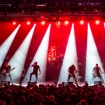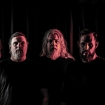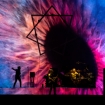Pick up limited-edition Meshuggah colored vinyl at Revolver's shop.
"It's all about human evil" was how Meshuggah drummer and lyricist Tomas Haake described his band's obZen LP to Revolver in early 2008, shortly before the album's release. "And that's where the album title comes from. Instead of using the word 'obscene,' we mixed it with 'Zen,' as in you've found your balance and equilibrium as a human being in the obscene, in violence and blood."
Just as its title joined two vastly different words to make a third meaning, obZen found the influential Swedish extreme/progressive metal band breathing new life into their already challenging music by combining the thrashy, proto-djent attack of earlier albums like 1995's Destroy Erase Improve and 1998's Chaosphere with the darker, more experimental approach of 2002's Nothing and 2005's Catch Thirtythree. The sinister and searing results reaffirmed Meshuggah's status as a premier force in modern metal, while also recalibrating the band's creative course.
However, the process of making the complex, multi-layered masterpiece was nearly as punishing as the music itself. "For obZen, we almost killed ourselves," Haake would later reflect in a 2012 interview with MSN.com. "We did things in a weird way, we spent too much time on vocals and stuff like that instead of going in and trying to get through the songs, have some good takes and not be too anal about everything from the get-go."
Though the album, Meshuggah's sixth, was originally slated for a November 2007 release, the band's ultra-intense work ethic pushed its release date back four months to March 7th, 2008; Meshuggah were even forced to bow out of a European tour with Dillinger Escape Plan in order to be able to finish the record. The end product was well worth the time and effort, however, as anyone who has ever banged their head to the polyrhythmic perfection of tracks like "Bleed," "Pineal Gland Optics" and "Dancers to a Discordant System" can attest.
In perpetual celebration of a modern classic, here are eight things you might not know about obZen.
1. The band were completely obsessed with getting the tracks perfect — like, really, really obsessed
Recording the album at their own studio — Fear and Loathing, located in Stockholm — meant that Meshuggah were able to put obZen together at their own pace, instead of worrying about racking up studio fees with every hour that passed. Unfortunately, this same freedom allowed the collective perfectionist streak of Haake and bandmates Jens Kidman (vocals), Fredrik Thordendal (lead guitar), Mårten Hagström (rhythm guitar) and Dick Lövgren (bass) to run riot. Haake alone took a month to record his drum tracks — typically recording between 20 to 30 takes for each passage of each of the album's nine songs — and then spent another month sorting through take after take, in order to compile the ultimate drum performance. Hagström, Thordendal and Lövgren were all similarly painstaking in recording their instrumental parts.
"We all wanted very, very much from this album," Haake told Revolver. "So everyone scrutinized their own stuff and redid a lot of the parts. We were continuously changing and tweaking the riffs to get everything right."
2. Jens Kidman hadn't heard any of obZen's songs before he went in to record the album's vocals
While most singers usually have at least a fairly good idea of what they'll be singing when it comes time to head into the studio, Meshuggah vocalist Jens Kidman went into the obZen sessions completely cold, without having heard any of his band's new material. Rather than allowing their singer to spend time with the basic tracks and start generating vocal ideas of his own, Haake and Thordendal scrupulously walked Kidman through every song, discussing various vocal approaches that might mesh best with each section — even though certain aspects of the compositions were still subject to change. Kidman wound up taking three months to complete the vocals, nearly losing his mind in the process.
"It was a pretty awkward feeling to do it that way," Kidman told Revolver. "And even after I did something, we often took away riffs and changed riffs and the vocals would have to be switched again. After a while, it was like being in The Twilight Zone. I was so focused that I forgot about time or what I did the day before. When I think about it now, I go, Did we even record an album? I don't remember that much."
3. The band lost perspective on the album so completely that they worried it might actually suck
"We did so much stuff, it was hard to have any perspective at all," Hagström recalled to Revolver. "And when you lack perspective, and you're creating this brutal music with so many parts, it's very hard to be confident. There were so many times I listened to it and I thought, 'Hey, this album sucks.' And then the next day I'd listen again and think it was one of the best things I ever heard. So then you start to feel, OK, which one's right? Some days everybody was just depressed, especially Fredrik."
"Fredrik wants everything perfect," Kidman told FaceCulture in a 2008 video interview. "He would be like, 'I have to re-do this guitar,' again for the 50th time. I'm like, 'Why?' 'Because it sucks!' 'No, it sounds perfect!' 'No!' He could stay there for two days and record until he feels it's perfect ... I'm happy that he's doing it, but he gets really worn out by it. He's so fucking focused, you could drop a hand grenade beside him, and he won't even notice."
4. The album's guitar tracks were recorded entirely without the use of microphones
Meshuggah's desire to create consistently savage guitar tones on a tight budget led them to become early adopters of digital amp-modeling technology. Rather than recording using mic'd-up tube or solid-state amplifiers, a process which can produce uneven results from day to day, they began recording their guitars via Line 6 pods on 2002's Nothing. By the time of the obZen, they'd graduated to the Line 6 Vetter II, an amplifier that could emulate over 70 different amp models; it could also run a signal directly into the recording desk, while being simultaneously mic'd — but the band quickly decided to do away with the microphones altogether.
"We basically plug straight in to the Line 6 and use the cab that we mic, and then we get the simulator to fade in by just plugging straight in — so we have two signals," Hagström explained to Guitar Messenger in 2008. "When we actually got around to record, we really early on realized that we would not be able to use the mic'd sound, because the cabinets were crapping out whenever we went to the really low stuff with palm muting. It actually worked out better to just do it from the straight signal, you know?"
5. "Bleed" almost didn't make it onto the album
One of Meshuggah's signature songs — according to Setlist.com, the band has now played it live more than any other song in their extensive catalog — "Bleed" actually came perilously close to being left off of obZen. "For a few months, we didn't know if we were going to have it on the album, or not," Haake told FaceCulture in 2010. "The problem for me, initially, was getting the whole [bass drum] pattern that the song is based on ... for me, it took a lot of time just to be able to play that properly."
Ultimately, it took nearly five months for Haake to be able to play the song's kick drum part like he heard it in his head; in order to fully nail it, he had to adopt a different approach to playing than he'd ever employed before. "I always used to just pummel really hard, and only [use] single strokes," he said in the same interview. "And for this one, I don't play as hard on the kicks ... on this one, I kind of keep my feet in the air. It's more like tap-dancing — you play it softer, but in a more fluid way. I probably spent more time on that track alone than all the other tracks on the album combined."
6. "Electric Red" evolved out of a leftover track from the Nothing LP
Another highlight from obZen, "Electric Red" began life as a throwaway track from the sessions for 2002's Nothing, which Haake and Holmström then stripped for parts like a stolen car in a chop shop. "We started with a song, 'Assembly,' that was supposed to be on Nothing, and we took it away, part by part," Holmström explained to Metal Underground in 2009. "Tomas came up with a new beginning, basically the entire theme of the song. Then when we came to the mid part, I jerked some parts and we came up with a totally new song. So what started out as being 2/3 of the Nothing song got stripped away and replaced. So there was just the last part left. Both me and Tomas thought there was an embryo in that song we wanted to finish, since we didn't get it on Nothing. We just did it for fun, and it turned out to be a cool song with some substance to it. And since it was only one part left over from the old song, it didn't feel like we were bringing in old stuff."

7. The album's disturbing cover art was judged to be too intense for American retailers
While Tomas Haake had previously handled most of Meshuggah's cover artwork himself, the band made the decision with obZen to outsource the cover, tapping Joachim Luetke, a German multimedia artist who had previously provided artwork for bands like Kreator, Arch Enemy and Dimmu Borgir, including the latter's darkly symbolic In Sorte Diaboli album cover. "We felt we needed something to not look generic like what we used to do," Hagström told the Gauntlet in 2009. "I like the old art, I like what Tomas does. He more than anyone felt it would be a fresh thing to get away from something drawn up and to do something with photo work."
Unfortunately, Luetke's photo collage of a bloody, three-armed, androgynous figure was apparently too much for American music retailers, so the band's label Nuclear Blast released the CD in the States with a slipcover (emblazoned with only the figure's head and "middle" hand) that hid the full image. "We just sent in the cover art and everyone told us it was fine," Hagström recalled. "Then we got word back it wasn't OK. It is kind of weird. The cover itself is uncensored; it just has a sleeve covering it. Not many people browse the records for cover art. Some do, but not the majority. I think that's why the label thinks it isn't as important, to us it is though."
8. Nuclear Blast's press kits for obZen contained an academic analysis of the band's music written by a university professor
In 2007, Music Theory Spectrum — an academic journal published by the Society for Music Theory — printed an article titled Re-casting Metal: Rhythm and Meter in the Music of Meshuggah. Written by City University of New York professor Jonathan Pieslak, the article took the reader through "an architectonic examination of the hierarchical layers" in the band's music, while also offering socio-cultural analysis of "the progressive/math-metal subgenre." Though far too dense for your average music fan (or music journalist) to decipher, the fact that the group had been subjected to such rigorous academic study further bolstered Meshuggah's fearsome musical reputation, so Nuclear Blast included print-outs of Pieslak's piece in the press kits they sent out to promote obZen.
While it's not surprising that Meshuggah's impressive musicianship and compositional skills would catch the ear of academics, the band themselves — none of whom had traditional musical training — took pains to demystify the perceived complexity of their music. "There is definitely more to our music than 4/4," Haake explained to the Miami New Times in 2008. "But the main thing is the 4/4 feel. For us, that's a very important aspect to it. It helps us in giving the music a certain amount of flow. You can actually — at least on a good night — get into a groove. If you want to translate it into being, 'here's this number of bars in 23/16 and this last part turns into 30 16th notes and starts over,' that's not how we perceive our music. It's just a matter of that last one flowing in an odd number over the 4/4 beat. Therefore, the 4/4 that we write and play around is the most important aspect. I usually play eighth notes on the hi-hat all the time, so everyone in the band can headbang."








